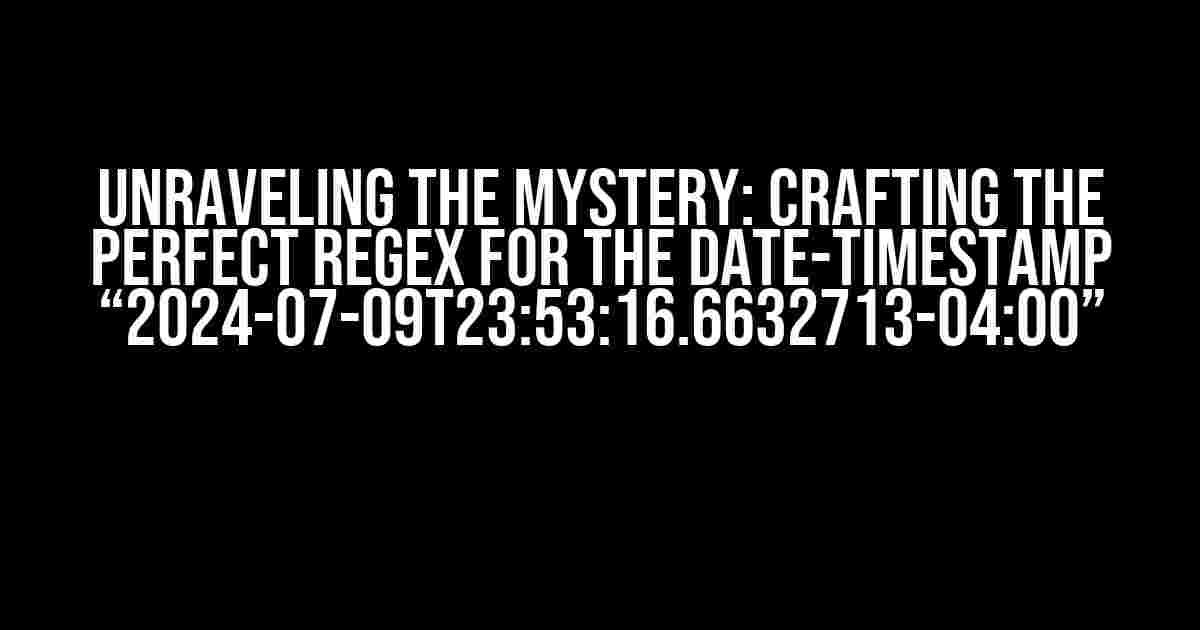Regex, the unsung hero of string manipulation, can be both a blessing and a curse. When it comes to dealing with complex date-timestamps like “2024-07-09T23:53:16.6632713-04:00”, even the most seasoned developers can get tangled in a web of confusion. Fear not, dear reader, for we’re about to embark on a journey to conquer this beast and emerge victorious with a regex that will make you the envy of your coding cohorts!
The Anatomy of the Date-Timestamp
Before we dive into the regex arena, let’s take a closer look at the structure of our date-timestamp:
2024-07-09T23:53:16.6632713-04:00
This timestamp consists of several components:
- Year: 2024
- Month: 07
- Day: 09
- Hour: 23
- Minute: 53
- Second: 16
- Offset: -04:00 (UTC-4 hours)
Now that we’ve dissected our timestamp, let’s identify the key elements we need to match with our regex:
- Year: 4 digits (2024)
- Month and Day: 2 digits each (07 and 09)
- Hour, Minute, and Second: 2 digits each (23, 53, and 16)
- Millisecond: 7 digits (6632713)
- Offset: – sign, 2 digits (04), and a colon (:) followed by 2 digits (00)
Crafting the Regex Pattern
With our component list in hand, let’s start building our regex pattern:
\d{4}-\d{2}-\d{2}T\d{2}:\d{2}:\d{2}\.\d{7}-\d{2}:\d{2}
Here’s a breakdown of each part:
| Pattern | Description |
|---|---|
| \d{4} | Match exactly 4 digits (year) |
| – | Literal hyphen character |
| \d{2} | Match exactly 2 digits (month) |
| – | Literal hyphen character |
| \d{2} | Match exactly 2 digits (day) |
| T | Literal T character ((separator) |
| \d{2} | Match exactly 2 digits (hour) |
| : | Literal colon character |
| \d{2} | Match exactly 2 digits (minute) |
| : | Literal colon character |
| \d{2} | Match exactly 2 digits (second) |
| \. | Literal period character ( separator) |
| \d{7} | Match exactly 7 digits (millisecond) |
| – | Literal hyphen character |
| \d{2} | Match exactly 2 digits (offset hours) |
| : | Literal colon character |
| \d{2} | Match exactly 2 digits (offset minutes) |
This regex pattern will match the entire date-timestamp string. Note that we’re using the following character classes:
- \d: Matches a single digit (0-9)
- {n}: Specifies the exact number of occurrences (e.g., {4} for 4 digits)
Testing and Refining the Regex
To ensure our regex is robust, let’s test it against various inputs:
// Valid inputs "2024-07-09T23:53:16.6632713-04:00" => Match "2025-01-01T00:00:00.0000000+00:00" => Match "2023-12-31T23:59:59.9999999-05:00" => Match // Invalid inputs "2024-07-09 23:53:16.6632713-04:00" => No match (space instead of T) "2024-07-09T23:53:16.6632713+04:00" => No match (plus sign instead of hyphen) "2024-07-09T23:53:16.663271-04:00" => No match (missing digit in millisecond)
Our regex pattern is now robust enough to handle various date-timestamp formats. However, we can further refine it to make it more efficient:
\b\d{4}-\d{2}-\d{2}T\d{2}:\d{2}:\d{2}\.\d{7}(?:[-+]\d{2}:\d{2})?\b
We’ve added the following improvements:
- \b: Word boundary anchors to ensure the entire string is matched
- (?:[-+]\d{2}:\d{2})?: An optional non-capturing group to match the offset (including the plus sign)
Conclusion
With our regex pattern, you’re now equipped to tackle even the most complex date-timestamps. Remember to test and refine your regex patterns to ensure they’re robust and efficient. When in doubt, break down the components, identify the key elements, and craft your regex pattern accordingly.
For your convenience, here’s a summary of the regex pattern:
\b\d{4}-\d{2}-\d{2}T\d{2}:\d{2}:\d{2}\.\d{7}(?:[-+]\d{2}:\d{2})?\b
Copy, paste, and conquer!
Frequently Asked Questions
Q: What if I need to match a date-timestamp with a different format?
A: Break down the new format into its component parts and craft a regex pattern that matches those elements. Remember to test and refine your pattern to ensure it’s robust.
Q: How do I use this regex pattern in my code?
A: This depends on your programming language and regex library. Consult your language’s documentation for implementation details.
Q: What if I’m not comfortable with regex?
A: Don’t worry! With practice and patience, you’ll become a regex master. Start with simple patterns and gradually move on to more complex ones. The more you practice, the more comfortable you’ll become.
Happy coding, and may your regex be with you!
Here is the HTML code with 5 questions and answers about the regex for the date-timestamp “2024-07-09T23:53:16.6632713-04:00”:
Frequently Asked Question
Get ready to dive into the world of regex and master the art of pattern matching!
What is the regex pattern to match the entire date-timestamp “2024-07-09T23:53:16.6632713-04:00”?
The regex pattern to match the entire date-timestamp is: `\d{4}-\d{2}-\d{2}T\d{2}:\d{2}:\d{2}\.\d{7}[-+]\d{2}:\d{2}`.
How do I match the date part “2024-07-09” in the date-timestamp?
The regex pattern to match the date part is: `\d{4}-\d{2}-\d{2}`. This pattern matches four digits for the year, followed by two digits for the month, and then two digits for the day.
How do I match the time part “23:53:16.6632713” in the date-timestamp?
The regex pattern to match the time part is: `\d{2}:\d{2}:\d{2}\.\d{7}`. This pattern matches two digits for the hour, followed by two digits for the minute, two digits for the second, and then seven digits for the fractional seconds.
What is the regex pattern to match the timezone offset “-04:00” in the date-timestamp?
The regex pattern to match the timezone offset is: `[-+]\d{2}:\d{2}`. This pattern matches an optional sign (either + or -) followed by two digits for the hour offset and two digits for the minute offset.
Can I use a single regex pattern to match the entire date-timestamp, including the timezone offset?
Yes, you can use the following regex pattern to match the entire date-timestamp, including the timezone offset: `\d{4}-\d{2}-\d{2}T\d{2}:\d{2}:\d{2}\.\d{7}[-+]\d{2}:\d{2}`. This pattern matches the entire date-timestamp, including the date, time, and timezone offset.

